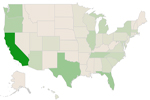Electricity Production and Distribution
All-electric vehicles and plug-in hybrid electric vehicles (PHEVs)—collectively referred to as electric vehicles (EVs)—store electricity in batteries to power one or more electric motors. The batteries are charged primarily by plugging in to off-board sources of electricity, produced from natural gas, nuclear energy, coal, wind energy, hydropower, and solar energy.
All-electric vehicles, as well as PHEVs operating in all-electric mode, do not produce tailpipe emissions. However, there are emissions associated with the majority of electricity production in the United States. See the emissions section for more information on local electricity sources and emissions.
Production
According to the U.S. Energy Information Administration, most of the nation's electricity was generated by natural gas, renewable sources, coal, and nuclear energy in 2022. Renewable sources of electricity include wind, hydropower, solar power, biomass, and geothermal. Together, these sources generated about 20% of the country's electricity in 2022.
To produce electricity, a turbine generator set converts mechanical energy to electrical energy. In the cases of natural gas, coal, nuclear fission, biomass, petroleum, geothermal, and solar thermal, the heat that is produced is used to create steam, which moves the blades of the turbine. In the cases of wind power and hydropower, turbine blades are moved directly by flowing wind and water, respectively. Solar photovoltaic panels convert sunlight directly to electricity using semiconductors.
The amount of energy produced by each source depends on the mix of fuels and energy sources used in your area. To learn more, see the emissions section. Learn more about electricity production from the U.S. Department of Energy's Energy Information Administration.
Electricity Transmission and Distribution
Electricity in the United States often travels long distances from generating facilities to local distribution substations through a transmission grid of nearly 160,000 miles of high-voltage transmission lines. Generating facilities provide power to the grid at low voltage, from 480 volts (V) in small generating facilities to 22 kilovolts (kV) in larger power plants. Once electricity leaves a generating facility, the voltage is increased, or "stepped up," by a transformer (typical ranges of 100 kV to 1,000 kV) to minimize the power losses over long distances. As electricity is transmitted through the grid and arrives in the load areas, the voltage is stepped down by substation transformers (ranges of 70 kV to 4 kV). To prepare for customer interconnection, the voltage is lowered again (residential customers use 120/240 V; commercial and industrial customers typically use 208/120 V, or 480/277 V).
Electric Vehicles and Electricity Infrastructure Capacity
Demand for electricity rises and falls, depending on time of day and time of year. Electricity production, transmission, and distribution capacity must be able to meet demand during times of peak use; but most of the time, the electricity infrastructure is not operating at its full capacity. As a result, EVs are unlikely to require expanded grid capacity.
Although increasing demand associated with charging EVs is not likely to strain much of our existing generation resources, high coincident peaks of EV charging in concentrated locations could strain nearby distribution equipment. According to a U.S. Department of Energy report, planning and forecasting for EVs should include assessments of the micro or distribution circuit level since the impacts and infrastructure investments needed will be highly localized. Advanced grid planning and solutions, such as smart charge management, will be important to ensure existing electrical infrastructure can safely support areas with large increases in demand related to EVs depending on when, where, and at what power level the vehicles are charged.
According to deployment models developed by researchers at the National Renewable Energy Laboratory (NREL), the diversity of household electricity loads and EV loads should allow introduction and growth of the EV market while "smart grid" networks expand. Smart grid networks allow for two-way communication between the utility and its customers, and sensing along transmission lines through smart meters, smart appliances, renewable energy resources, and energy efficient resources. Smart grid networks may provide the capability to monitor and protect residential distribution infrastructure from any negative impacts due to increased vehicle demand for electricity because they promote charging during off-peak periods, and reduce costs to utilities, grid operators, and consumers.
The NREL analysis also demonstrated the potential for synergies between EVs and distributed sources of renewable energy. For example, small-scale renewables, like solar panels on a rooftop, can both provide clean energy for vehicles and reduce demand on distribution infrastructure by generating electricity near the point of use. For utilities to fully realize the benefits of these technologies, smart charge management must be deployed to influence EV charging.
Utilities, vehicle manufacturers, charging equipment manufacturers, and researchers are working to ensure that EVs are smoothly integrated into the U.S. electricity infrastructure. Some utilities offer lower rates at off-peak times to encourage residential vehicle charging when electricity demand is lowest. Vehicles and many types of charging equipment (also known as electric vehicle supply equipment or EVSE) can be programmed to delay charging to off-peak times. "Smart" models are even capable of communicating with the grid, load aggregators, or facility/home owners, enabling them to charge automatically when electricity demand and prices are best; for example when prices are lowest, aligned with local distribution needs (such as temperature constraints), or aligned with renewable generation.

